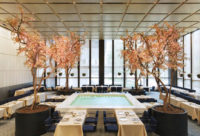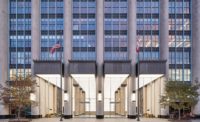New York
Like a man stumbling out of his cryogenic pod, a project revived after cooling on ice for decades enters a world that is oddly familiar, but largely unknown. Resurrection is risky: Will the work still be relevant? Can it remain faithful to the designer's original intent? Such questions have swirled around the Franklin D. Roosevelt Four Freedoms Park in New York City, a memorial designed by Louis I. Kahn shortly before his death in 1974. Now, after 38 years, the park is ready to open to the public on October 24.
At the southern tip of Roosevelt Island, a gleaming white granite exclamation point braces against the currents of the East River between Manhattan and Queens. Composed of a triangle and a square, the symmetrical four-acre park has a simple, two-part idea. 'I had this thought that a memorial should be a room and a garden. That's all I had ' I just chose it to be the point of departure,' Kahn said in a 1973 lecture. The garden is 'a personal kind of control of nature. And the room was the beginning of architecture ' an extension of self.' As Kahn intended, too, it is a spiritual place. It not only imparts the feeling of the structure's eternity'which he understood as defining monumentality in architecture'but it also prompts the visitor, in the face of such heft and solidity, to contemplate her own role in the larger scheme of things.
Two miles long and 800 feet wide, Roosevelt Island, despite its proximity to Manhattan, was always on the fringes, hosting penitentiaries, almshouses, insane asylums, and hospitals for 'incurables.' In 1973'as plans to transform the island to a middle-class residential enclave developed'the New York State Urban Development Corporation (UDC) renamed the sliver of land, previously known as Welfare Island, and presented the public with a model of the Kahn memorial. The weight of the commission was not lost on the architect. New Deal programs had kept him employed early in his career. 'Roosevelt was a very big deal in our house, and the betterment of mankind was a paramount theme within our family, as is apparent through my father's drive to enrich people's lives through architecture,' says the late architect's daughter, Sue Ann Kahn, who has been informally involved with reviving the project since the 1990s.
Just before Kahn's death in March 1974, the Four Freedoms Foundation (FFF) and the New York State UDC approved the architect's preliminary design for the memorial. Of course, because he was known for holding off on decisions as long as possible, many of them'subtle, perhaps, but important'had yet to be made. A number of Kahn's staff, including his former associate and office manager, David Wisdom, worked together to complete the drawings, and entered a joint venture with the New York office of Mitchell/Giurgola (among other things, the team required an architect registered in the state who could sign off on the drawings). Aldo Giurgola, a friend of Kahn's, let the Kahn office take the lead. Over the years, despite numerous attempts to jump-start the project by the Franklin and Eleanor Roosevelt Institute (the successor of FFF) and its chairman, William vanden Heuvel, political will and financial might never seemed to coincide. Finally, in 2005, Chicago's Alphawood Foundation offered seed money, enabling vanden Heuvel to set up a project office, hire an executive director, and then, in 2008, establish the Franklin D. Roosevelt Four Freedoms Park, LLC (FDRFFP), as a subsidiary and construction entity. With private and public funding coming in, construction started in March 2010.
Just to the south of the romantic ruins of James Renwick's 1854 Smallpox Hospital (and the nearby site of Cornell University and Technion-Israel Institute of Technology's forthcoming tech campus) a monumental granite stair leads up to the triangular garden, a swath of sloping turf flanked by all'es of little-leaf linden trees. On either side, granite embankments drop down to swooping promenades, with broad riprap below that buffers the memorial from the East River (which is actually a tidal strait). Reflecting the influence of classical architecture on Kahn's work, forced perspective directs visitors' gazes and animates these expansive spaces. Beyond a cobblestone forecourt, the triangle comes to a literal head at the 1,050-pound bronze bust of FDR'an enlargement of a sculpture by Jo Davidson. It sits in a niche on the back of which is carved part of FDR's famous 1941 'Four Freedoms' speech to Congress, in which he articulated four essential human freedoms to which he believed everyone was entitled: freedom of speech and expression, freedom to worship, freedom from want, and freedom from fear.
The head marks the threshold to the room, which is walled in by monolithic, 36-ton blocks of saw-cut Mount Airy granite from North Carolina'the only stone used on the project, and one of three that Kahn had originally selected. They are set just 1 inch apart, and the faces inside the joint have a polished finish. 'The difficulty of both fabricating a block of this size and keeping the very, very precise edges and the very tight tolerances that Kahn would have demanded was incredibly challenging to everybody,' says FDRFFP executive director Gina Pollara, who trained as an architect and who, over the last six years, has helped shepherd the project to completion. Pollara notes that while the original drawings had a 1/32-inch tolerance, this team built with a (still impressive) 1/8-inch tolerance. The rigidity of the execution shows. And cinematic moments abound. A trench (or ha-ha) at the room's prow obviates the need for a railing, allowing sweeping views out to Manhattan'and, fittingly, the United Nations complex'and gives a visitor the impression that you could walk right off the edge into the water.
The team wanted to be as true to the original design as possible, but adjustments (particularly given improved technology) were inevitable. 'In bringing the project up to current construction standards, and addressing building-code requirements and climate change, the challenge was to structure the underpinnings without changing the appearance of the project in any way,' says Paul Broches of Mitchell/Giurgola. The team raised the park elevation by about 15 inches to accommodate the rising sea level. In the room they added caissons to support concrete footings and threaded steel rods through the granite foundation walls and columns to resist environmental loading, including flooding, wave forces, and seismic load. The lighting scheme was expanded (to illuminate the little-leaf lindens and the bust, in addition to the specified beech trees), as was the tree grid, which grew from 10 by 10 feet to 12 by 15 feet on advice of consulting arborists.
The team availed themselves of advanced technology and products, such as modern grouts, and made updates in accordance with ADA accessibility, including replacing gravel on the footpaths between the all'es with stabilized crushed granite, which, unfortunately, lacks the satisfying crunch and glint of the loose stone. 'People have gone to every possible length to make the memorial as close to my father's intentions, insofar as they could determine what they were,' says Sue Ann Kahn. 'I do think it's a miracle it was accomplished. And I think he would be pleased.'
Traversing the park is like being on a ship coursing into a bright beyond. Standing in the still coolness of the all'es, or in the dazzlingly bright room where waves crash against the foundation and the big city skyline is surreally suspended across the water, is an experience that transcends time, like the structure itself, which feels both ancient and modern. 'What was has always been. What is has always been. What will be has always been,' said Kahn. 'Such is the nature of beginning.' It has been a long time coming, but what a beginning this is. Kahn knew as well as anyone that great monuments take time to build.
Location:
FDR Four Freedoms Park, Roosevelt Island, New York City
Total construction cost: $44.5 M
Completion date: October 2012
Size: 4 acres
PeopleArchitect: Louis I. Kahn (deceased) Client: Franklin D. Roosevelt Four Freedoms Park, LLC — Ambassador William J. vanden Heuvel, chairman; Sally Minard, president; Project Office: Gina Pollara, executive director; Stephen Martin, associate director; John Conaty, owner’s representative Architect of Record: Mitchell/Giurgola Architects — Paul Broches, partner in charge; John Kurtz, design partner; Valerie DeLoach, project architect Engineers: Langan Engineering and Environmental |
ProductsGranite quarry & fabrication: North Carolina Lighting: iGuzzini Bronze Head: Polich Tallix Fine Art Foundry Trees: Halka Nurseries (little-leaf lindens); Whitmores Landscaping (copper beeches) |















Post a comment to this article
Report Abusive Comment